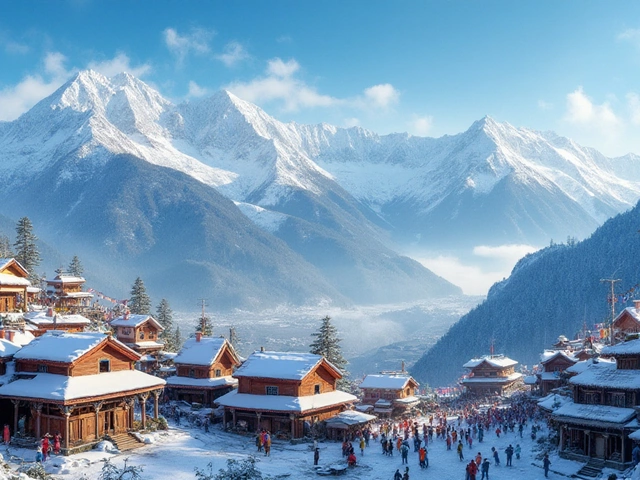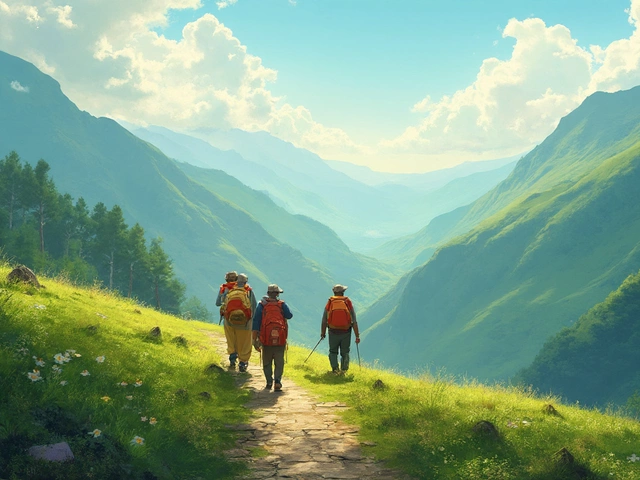Agra. Just mention the name, and the iconic image of the Taj Mahal likely springs to mind. Sure, that white marble beauty grabs all the headlines, but Agra's got a lot more going on than just one pretty face. Let's dig into why this city is such a sensation in North India's tourism scene.
First up, the Taj Mahal. This isn’t just some overhyped tourist trap; it’s a genuine masterpiece of love and architecture. Built by Emperor Shah Jahan for his beloved wife Mumtaz Mahal, it took over 20 years and 20,000 workers to complete. Visiting this monument is like stepping into a love story etched in stone.
Now, don't skedaddle after you've seen the Taj. Agra Fort is calling your name. This UNESCO World Heritage Site has been standing tall since the 16th century and it's packed with history and stunning views that just might steal your heart. Wandering through its grand palaces and courts is like flipping through the pages of a history book.
- The Allure of the Taj Mahal
- Exploring Agra Fort
- Unveiling Fatehpur Sikri
- Agra's Local Flavors
- Shopping Surprises and Handy Tips
The Allure of the Taj Mahal
Alright, let’s talk about what makes the Taj Mahal an absolute showstopper. This iconic monument isn't just famous; it's a symbol of love carved in stone, attracting millions of visitors from around the globe. Set on the banks of the Yamuna River, it's a spectacle that mixes romance with sheer architectural brilliance.
The tale behind this marvel is as captivating as its shimmering white marble. It was commissioned in 1632 by Emperor Shah Jahan for his favorite wife, Mumtaz Mahal. This wasn’t just any mausoleum; it was his way of immortalizing his love. What you get is not just a tomb, but an elaborate work of art that's both intimate and grand.
Everyone swoons over its main dome, which stands at about 240 feet high. But don’t miss the intricate floral carvings and the extensive inlay work with precious and semi-precious stones. It's all in the details, folks. Even famous writer Rabindranath Tagore called it a "teardrop on the cheek of time," and it’s hard not to agree when you’re standing in its shadow.
"It’s a symbol of the eternal love story that inspires and captivates everyone who visits," says historian William Dalrymple.
The Taj Mahal isn’t just about its beauty. The complex includes lush gardens and reflection pools that create a serene and otherworldly atmosphere. Heads up: visiting during sunrise or sunset can magnify these effects, with the sun casting magical hues on the marble.
For the best experience, I’d recommend heading out early to avoid the crowds. Visiting between October and March is ideal because the weather’s less likely to make you feel like a dehydrated fish.
Here's a fun little table breaking down the estimated number of visitors per year:
| Year | Visitors (in millions) |
|---|---|
| 2019 | 7 |
| 2020 | 5 (due to global travel restrictions) |
| 2021 | 5.5 |
The allure of the Taj isn’t just some fairy tale; it’s an actual, palpable experience that sticks with you long after you’ve left. So whether you're a history buff, architecture geek, or just someone who loves a good love story, the Taj Mahal is a destination that lives up to its hype.
Exploring Agra Fort
While the Agra Fort might play second fiddle to its glamorous neighbor, the Taj Mahal, it's certainly a star in its own right. This massive red sandstone fort was built by the great Mughal Emperor Akbar in the late 16th century. It's not just a simple fort; think of it as a walled city that tells the tales of a powerful empire.
One of the coolest things about the fort is its architecture. You’ll see a mix of Hindu and Islamic styles, which reflects the melting pot that the Mughal Empire really was. The fort's design is a journey through history, with palatial buildings like the Jahangir Palace, made for Akbar's son, and the Khas Mahal, an elegant white marble palace.
Now, if you're the kind of person who likes a bit of drama with your history, the Musamman Burj is your spot. This is where Emperor Shah Jahan was kept under house arrest by his own son, Aurangzeb. It's said he spent his days gazing at the Taj Mahal, mourning his deceased wife. Talk about a bittersweet view.
Wandering through the fort, you might be surprised by the Diwan-i-Khas, or the Hall of Private Audience. This is where the emperor would hold private meetings. Can you imagine the political goings-on that happened in those walls? It's impressive to think people were plotting and scheming in the very place you're standing.
And hey, before you leave, don’t skip the Amar Singh Gate, the grand entrance to this massive fort. It's the main gate, and though security’s tight now, it was once bustling with soldiers and horses. If you’ve got time, engage a local guide. They often share stories and secrets you might miss by just wandering on your own.
If you're looking for some cool stats, check this out:
| Year Constructed | Area Covered | Architectural Style |
|---|---|---|
| 1565-1573 | 94 acres | Mughal |
Agra really offers more than stunning views; it’s about savoring the whispers of history echoing through its walls.
Unveiling Fatehpur Sikri
Just a hop, skip, and jump from Agra, Fatehpur Sikri is like a hidden chapter in the book of India's Mughal era. This place was once the capital of the Mughal Empire under Emperor Akbar. Yep, the same Akbar known for being a pretty savvy ruler. It's like stepping into a royal ghost town, beautifully preserved, where ancient whispers hang in the air.
History tells us Akbar built this city in the late 1500s, but it was abandoned in just a few years. Why? Well, they had serious water issues. Despite this hiccup, the architecture remains stunning, with sandstone buildings glowing in the sunlight
The main pulling point here is the Buland Darwaza, which stands at 54 meters tall. It's not just big; it's awesome in the truest sense of the word and a must-see if you visit. And then there's the Jama Masjid, one of the largest in India, offering peace amidst grandeur.
Don't skip the Diwan-i-Khas, which was Akbar's cool hangout spot. Here, he would hold meetings and display his multicultural court through the Pillar of Akbar. Talk about a guy ahead of his time; he built a religiously inclusive society when most were still figuring out basic diplomacy.
Oh, and keeping the travel practical, you might want to spare yourself a day just for Fatehpur Sikri. It's close enough to Agra for a day trip, but there’s enough to see that you won't want to rush it.
When visiting, consider the following tips:
- Visit early or late in the day to avoid crowds and midday heat.
- Wear comfortable walking shoes because you'll be traveling back to the 16th century on foot.
- Don't miss trying some local snacks from vendors outside the complex. Authentic flavors you won't find anywhere else!
So, when in North India, don't just stick to the well-trodden tourist paths. Fatehpur Sikri is a hidden gem that offers history buffs and casual travelers alike a glimpse into the past with all its grandeur and quirks.
Agra's Local Flavors
Agra isn't just about jaw-dropping architecture; it's also a treat for your taste buds. This city boasts a culinary landscape as rich as its history. From street food to more sophisticated bites, there's something to satisfy every craving. What better way to experience Agra tourism than through its delicious dishes?
Ever heard of petha? This sweet delicacy made from ash gourd is one of Agra's most famous treats. It's available in different flavors and colors, and you absolutely need to try it. Just head over to Panchhi Petha, which has been around for ages and serves some of the best in town.
Want something savory? Agra has you covered with its tantalizing chaats. Think spicy, tangy, and crispy. Try them at Sadar Bazaar and Kinari Bazaar, where stalls serve up plates of goodness like aloo tikki, golgappa, and dahi bhalla. These lively markets are buzzing with locals and travelers alike.
Being in North India, you can't miss out on the Mughlai cuisine. Strong influences from the Mughal era remain, with rich, creamy dishes like biryani, kebabs, and tandoori delights. Shankar Ji at Agra Cantt and Pinch of Spice are great spots to dig in without breaking the bank.
For something refreshing, don't skip the iconic Agra tea. Popular stalls like Mama Franky are a great place to try not only the chai but their popular egg rolls as well.
Ready for more? Here's a handy chart to guide your food adventures:
| Dish | Where to Try |
|---|---|
| Petha | Panchhi Petha |
| Chaat | Sadar Bazaar, Kinari Bazaar |
| Mughlai Dishes | Shankar Ji, Pinch of Spice |
| Tea and Snacks | Mama Franky |
There you have it—your unofficial guide to the culinary wonders of North India travel through Agra. Remember, the best souvenirs can sometimes be flavors that linger long after the trip is over!
Shopping Surprises and Handy Tips
So, you've walked the halls of the Taj and soaked in the rich history at Agra Fort—now what? It's time to dive into some retail therapy. Agra’s markets are buzzing with unique finds and local treats that make perfect souvenirs of your North India travel adventure.
Agra tourism isn't just about gazing at monuments; it's also about capturing a little piece of the culture to bring home. First stop? Sadar Bazaar. This place is a lively hub where you can haggle for leather goods, vibrant handicrafts, and, of course, the infamous Petha, a sweet treat that Agra's absolutely known for.
Looking for something a bit more upscale? Check out the Raja Ki Mandi for its funky clothes and cool accessories. Don’t miss Kinari Bazaar if you're hunting for textiles and ethnic wear. Its narrow lanes might feel like a maze, but they lead to treasure troves you won't want to miss.
If you've got a sweet tooth, stop by any of the numerous Petha shops around town. Agra's Petha comes in all sorts of flavors, so grab a few different kinds to see what you like best. Also, if you're into souvenirs, remember that Agra is famous for its marble replicas of the Taj Mahal. Just make sure what you're buying is authentic by checking the quality and asking around a bit.
Shopping in Agra can be a little overwhelming with its bustling streets and crowds, so here are some handy tips:
- Always barter. Most shopkeepers expect it, and you can often score a good deal.
- Be mindful of your belongings—keep your cash close and your bags closer.
- If you're planning to buy big-ticket items like rugs or jewelry, make sure to get a certificate of authenticity.
Check out the table below for some average costs to keep in mind while shopping:
| Item | Average Cost (INR) |
|---|---|
| Leather Goods | 700-1,500 |
| Textiles | 500-2,000 |
| Petha | 100-300 per box |
| Marble Souvenirs | 300-2,500 |
These experiences and tips ensure that Agra attractions include more than just sightseeing—you're also in for a great shopping story to tell when you're back home!


